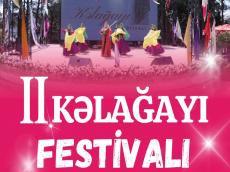|
|
TODAY.AZ / Arts & Entertainment
Baku to host Kalaghayi Festival for second time
03 September 2025 [12:56] - TODAY.AZ

The 2nd Kalaghayi Festival will be organized on September 20 by the Mirvarid Dilbazi Poetry Assembly Public Union, with the support of the Khatai District Executive Authority.
The event will take place in the amphitheater located in the Heydar Aliyev Park, Khatai district.
The festival will feature an exhibition, an official opening ceremony, and a concert program. Representatives from state institutions, renowned singers, ashiks, and poets will participate in the concert.
The exhibition will showcase 200 ancient kalaghayi headscarves created by Gullu Eldar Tomarli for the Kalaghayi House-Museum," as well as other decorative and applied art examples, museum artifacts, and books about kalaghayi. In addition, there will be a display and sale of kalaghayi made by artisans from Sheki and Basqal.
It is noteworthy that kalaghayi, thanks to the initiative of Azerbaijan’s First Vice President and President of the Heydar Aliyev Foundation, Mehriban Aliyeva, was included in UNESCO's Representative List of the Intangible Cultural Heritage of Humanity in 2014 and recognized internationally.
The first Kalaghayi Festival, held in 2024 to mark the 10th anniversary of this landmark event, began in Xetai district and continued in Surakhani, Yasamal, the Nakhchivan Autonomous Republic, and St. Petersburg.
Kalaghayi is a traditional Azerbaijani women's headscarf made from fine, soft silk and typically crafted in a four-cornered shape. For centuries, it has been an essential part of Azerbaijani women's national attire, offering protection from both the scorching sun and cold winds, as silk provides coolness in summer and warmth in winter.
The colors of the kalaghayi hold symbolic meaning, often associated with specific life events, such as weddings, mourning ceremonies, daily activities, or festive occasions.
The intricate designs often feature a blend of botanical motifs leaves and flowers intertwined with complex geometric patterns, creating a captivating visual effect. These compositions, made up of both botanical and geometric elements, carry symbolic and mysterious significance.
The central motif of kalaghayi is the buta, a twisted teardrop shape, an ancient symbol representing divine fire, which has been revered in Azerbaijan for centuries.
Kalaghayi was traditionally tied in various ways depending on the region. In some areas, it was worn over a kerchief, which was used to gather the hair. Young girls typically didn’t cover their heads with kalaghayi but used it as an accessory, tying it beautifully around their necks or draping it over their shoulders.
Among the most famous kalaghayi designs are "Shah buta," "Saya buta," "Khirda buta," "Heyrati," "Soghani," "Istiotu," "Albukhari," "Abi," "Gonshuchatladan," "Baghdadi," "Shamakhi," "Bestenigar," "Gelinlik," "Gizili," "Mikheyi," "Yemishani," "Zeytuni," and "Yelani."
In November 2014, during the 9th session of UNESCO, the traditional art, symbolism, production, and wearing of kalaghayi were officially recognized as part of the Intangible Cultural Heritage of Humanity.
As a symbol of beauty, grace, and honor, kalaghayi continues to be a vibrant and cherished element of Azerbaijani women's traditional clothing.
URL: http://www.today.az/news/entertainment/261679.html
 Print version
Print version
Connect with us. Get latest news and updates.
See Also
- 18 December 2025 [14:53]
Culture Ministry listed among winners of MilliNet 2025 competition - 18 December 2025 [13:33]
Opera 'Nasimi' to be presented in new AI-Powered stage production - 18 December 2025 [12:56]
Live-Show: Czechia through eyes of Azerbaijani artists - 17 December 2025 [13:11]
Culture Ministry, UNAOC explore new opportunities for cooperation - 17 December 2025 [11:56]
Master classes on tar and piano held in Mingachevir - 16 December 2025 [12:48]
Anthology 'Classic Czech Short Stories' in Azerbaijani presented in Prague - 16 December 2025 [12:27]
Azerbaijani tenor shines at London’s Royal Opera House - 16 December 2025 [12:17]
Azerbaijan represented at int'l exhibition in Algeria - 16 December 2025 [11:41]
Culture Minister participates in UNAOC Group of Friends High-Level Meeting - 16 December 2025 [10:42]
Navruz ensemble shines at Uzbekistan Culture Days
Most Popular
 Hornet's nest has been stirred up: how topic of Western Azerbaijan scared revanchists
Hornet's nest has been stirred up: how topic of Western Azerbaijan scared revanchists
 Huawei debuts new smartphones and devices in Argentina
Huawei debuts new smartphones and devices in Argentina
 Azerbaijan, Turkiye sign pact to strengthen military security
Azerbaijan, Turkiye sign pact to strengthen military security
 Russia open to consultations on TRIPP initiative with Armenia
Russia open to consultations on TRIPP initiative with Armenia
 Why Iran fears Corridor that Armenia sees as lifeline
Why Iran fears Corridor that Armenia sees as lifeline
 PM Asadov mulls regional co-op and North-South corridor with Astrakhan governor
PM Asadov mulls regional co-op and North-South corridor with Astrakhan governor
 China traffic police get AI glasses to check vehicles
China traffic police get AI glasses to check vehicles
